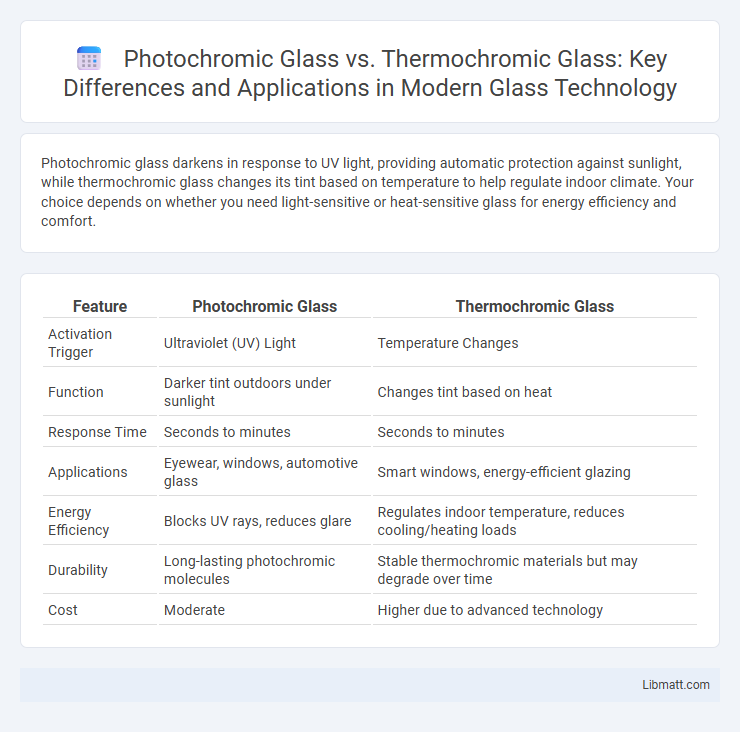Photochromic glass darkens in response to UV light, providing automatic protection against sunlight, while thermochromic glass changes its tint based on temperature to help regulate indoor climate. Your choice depends on whether you need light-sensitive or heat-sensitive glass for energy efficiency and comfort.
Table of Comparison
| Feature | Photochromic Glass | Thermochromic Glass |
|---|---|---|
| Activation Trigger | Ultraviolet (UV) Light | Temperature Changes |
| Function | Darker tint outdoors under sunlight | Changes tint based on heat |
| Response Time | Seconds to minutes | Seconds to minutes |
| Applications | Eyewear, windows, automotive glass | Smart windows, energy-efficient glazing |
| Energy Efficiency | Blocks UV rays, reduces glare | Regulates indoor temperature, reduces cooling/heating loads |
| Durability | Long-lasting photochromic molecules | Stable thermochromic materials but may degrade over time |
| Cost | Moderate | Higher due to advanced technology |
Introduction to Smart Glass Technologies
Smart glass technologies include photochromic and thermochromic glass, both designed to regulate light and heat transmission based on environmental stimuli. Photochromic glass changes its tint when exposed to ultraviolet (UV) light, offering enhanced protection from sunlight and reducing glare. Thermochromic glass adjusts its opacity in response to temperature changes, optimizing energy efficiency by controlling solar heat gain in buildings and vehicles.
What is Photochromic Glass?
Photochromic glass contains molecules that change tint in response to ultraviolet (UV) light, darkening when exposed to sunlight and returning to clear indoors or in low UV conditions. This smart glass technology enhances comfort by reducing glare and UV radiation transmission without compromising visibility. Commonly used in eyewear and architectural applications, photochromic glass adapts dynamically to environmental light changes.
How Photochromic Glass Works
Photochromic glass contains molecules that react to ultraviolet (UV) light, causing a chemical change that darkens the glass when exposed to sunlight. This reversible reaction allows the glass to tint automatically outdoors and return to a clear state indoors or in low UV conditions. Your vision benefits from reduced glare and enhanced comfort without manual adjustments, making photochromic glass ideal for eyewear and smart windows.
Overview of Thermochromic Glass
Thermochromic glass dynamically changes its tint based on temperature fluctuations, enhancing energy efficiency by reducing solar heat gain and improving indoor comfort. It contains materials that respond to heat by altering their optical properties, making it ideal for smart windows in buildings seeking passive climate control. This technology helps lower cooling costs and minimizes glare while allowing natural light to enter.
The Science Behind Thermochromic Glass
Thermochromic glass changes color in response to temperature fluctuations due to materials embedded within it that alter their molecular structure when heated or cooled. This process involves a reversible chemical reaction or phase change that modifies the glass's light absorption and reflection properties, effectively controlling heat and light transmission. Your choice of thermochromic glass can enhance energy efficiency by dynamically adapting to environmental temperatures without any electrical input.
Key Differences: Photochromic vs Thermochromic Glass
Photochromic glass darkens in response to UV light, automatically adjusting to changing outdoor light conditions, while thermochromic glass changes tint based on temperature variations, reacting to heat exposure. Photochromic lenses are common in eyewear for sun protection, whereas thermochromic glass is often used in smart windows or temperature indicators. Understanding these key differences helps you select the right material for specific applications requiring light or heat sensitivity.
Applications in Architecture and Design
Photochromic glass dynamically adjusts tint based on UV light exposure, making it ideal for smart windows in architecture that reduce glare and enhance energy efficiency. Thermochromic glass changes color with temperature variations, offering innovative facade solutions that respond to heat for climate-adaptive building envelopes. Your choice between these technologies depends on desired responsiveness to environmental factors and aesthetic impact in architectural and interior design projects.
Advantages and Disadvantages of Each Type
Photochromic glass automatically adjusts its tint in response to UV light, offering excellent protection from glare and UV rays while maintaining clear visibility indoors, but it may react slowly in certain lighting conditions and does not respond to heat changes. Thermochromic glass changes its tint based on temperature, providing efficient heat regulation by darkening in high temperatures to reduce solar heat gain, yet its sensitivity to temperature rather than light means it may not block glare effectively in shaded or indoor environments. Your choice depends on whether light control or temperature regulation is more critical for your application, balancing factors like reaction speed, energy savings, and environmental responsiveness.
Cost Comparison and Market Availability
Photochromic glass generally costs more than thermochromic glass due to its complex chemical composition and broader applications in eyewear and automotive industries. Thermochromic glass tends to be more affordable, with growing use in smart windows and temperature-sensitive products, but its market availability is less widespread compared to photochromic glass. Both types face supply chain variations, but photochromic glass benefits from a more established global distribution network, influencing its higher market penetration.
Choosing the Right Glass for Your Needs
Photochromic glass darkens in response to UV light, making it ideal for eyewear and outdoor applications where light intensity varies. Thermochromic glass changes color or opacity based on temperature, suited for smart windows and energy-efficient building solutions. Selecting between these depends on exposure to sunlight versus temperature fluctuations, ensuring the glass functionality aligns with environmental conditions and intended use.
photochromic glass vs thermochromic glass Infographic

 libmatt.com
libmatt.com